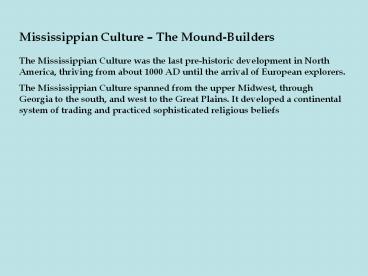Mississippian Culture - PowerPoint PPT Presentation
1 / 7
Title:
Mississippian Culture
Description:
Mississippian Culture The Mound-Builders The Mississippian Culture was the last pre-historic development in North America, thriving from about 1000 AD until the ... – PowerPoint PPT presentation
Number of Views:179
Avg rating:3.0/5.0
Title: Mississippian Culture
1
Mississippian Culture The Mound-Builders The
Mississippian Culture was the last pre-historic
development in North America, thriving from about
1000 AD until the arrival of European
explorers. The Mississippian Culture spanned
from the upper Midwest, through Georgia to the
south, and west to the Great Plains. It developed
a continental system of trading and practiced
sophisticated religious beliefs
2
Early Mississippian cultures (c. 1000-1200 A.D.)
abandoned tribal nomadic traditions for
increasing complexity, creating sedentary,
centralized communities based on agriculture.
The Middle Mississippian period (c. 1200-1400)
is considered the high point of Mississippian
culture. The formation of complex chiefdoms, most
notably at Cahokia in modern day Illinois and
Missouri. The Late Mississippian period (c.
1400 to European contact) is a time of warfare,
political turmoil, and migration.
People began abandoning Cahokia early in this
period (1350-1400). Sites have more defensive
structures and fewer mounds. Although some
areas continued to reflect a Middle Mississippian
culture until the first significant contact with
Europeans, most areas had dispersed or were
experiencing severe social stress by 1500.
http//www.learnnc.org/lp/editions/nchist-twoworld
s/2643
3
Coastal Algonquian At the time of first contact
with Europeans, the Algonquian tribes lived in
the tidewater areas of the Atlantic Coast. In
1584, about 7,000 Algonquians lived in North
Carolina. Having migrated to the south, they
kept some of the Northeastern Algonquian
traditions, but they also borrowed from their
neighbors as they adapted to the geographical and
climatic conditions of the area. They were more
water-oriented and emphasized hunting, fishing,
and gathering more than did most of their
neighbors.
4
Catawba The Catawba were Siouan-speaking
peoples and gave their name to the river that
dominates the Piedmont region of the Carolinas.
At that time of English contact there were about
6,000 Catawbas. The Catawba Nation was a
military alliance of several tribes decimated by
war and disease who joined the Catawba after the
Yamasee War in the 1710s. Their name means "cut
off," referring to their being cut off from other
Siouan tribes. They call themselves I Ye Ye,
"people," or Nieye, "real people."
5
Cherokee At the time of first contact with
Europeans, in the mid-16th century, the Cherokee
lived in the isolated valleys of the upper
Southern Appalachians. They are related
linguistically to the Iroquois to the north. By
the beginning of the 1700s, the Cherokee
territory had spread into southwestern Virginia,
western North Carolina, northwestern South
Carolina, eastern Tennessee and northern Georgia
and Alabama. You may abbreviate state names
6
The Cherokee are sometimes referred to as one of
the Five Civilized Tribes. The other four are
the Choctaw, Chickasaw, Creek, and Seminole. It
was an ethnocentric name given by white Americans
who saw these tribes becoming more Europeanized
in their culture. The Cherokee adopted European
clothing after the War of Independence and even
began to own black slaves. The Cherokee were
the first Indians to develop a written language.
In the 1820s, Sequoya created a syllabary (a type
of alphabet) which allowed the Cherokee language
to be written and translated. In the 1830s, the
Cherokee will be moved from their homelands in
Georgia to the Indian Territory in Oklahoma.
7
Trail of Tears When gold was discovered on
Cherokee land, Georgia brought it under state
control. The Cherokee sued. In Worcester v.
Georgia (1832), the Supreme Court ruled in favor
of the Cherokee, but Jackson refused to enforce
the ruling (saying, Marshall has made his
decision, now let him enforce it!) Jackson
bought the land and sold them land in the Indian
Territory. The Cherokee were forcibly moved into
stockades (concentration camps) and then removed
to Oklahoma in the winter of 1838. Walking 1200
miles during winter, more than 1/4 of the
Cherokee (c. 4,000 people) died. Some hid out in
western North Carolina and later received title
to land and became the Eastern Band of the
Cherokees.































